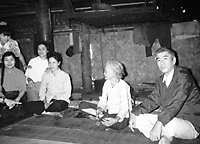Japan's Official Development Assistance White Paper 2007
Column 2 Eradicating Malaria
Olyset® Net Developed by Takaaki Ito of Sumitomo Chemical Co., Ltd.
Malaria is an infectious disease transmitted by mosquitoes hosting malaria plasmodium as they feed on human blood. It is accompanied by high fever, nausea, headache and other symptoms, and could be fatal in serious cases. As of today, the infection is confirmed in more than 100 countries, with over 300 million patients and more than 1 million deaths every year.* In particular, many children who have no resistance to the disease tend to lose their lives. Therefore, prevention is becoming a pressing task for the world.
Since there is no vaccine against malaria, the best way to prevent it is to avoid mosquito bites. Malaria-transmitting mosquitoes are active during the night, so it is crucial to keep them off during sleep. Use of mosquito nets, which is a traditional custom during the summer in Japan, is now recognized as one of the most effective ways of preventing malaria. Today, WHO, UNICEF, the World Bank and other international organizations are running a worldwide campaign to promote the use of mosquito nets which have special insecticidal effects.
The development of this mosquito net owes largely to the effort of Takaaki Ito, a Japanese chemical expert at Sumitomo Chemical Co., Ltd. He began his career with this company in the agricultural chemicals section. After 10 years working in the company, he was transferred to the section to develop household pesticides, and was instructed to conduct research on infectious diseases including malaria. That was his first encounter with malaria, and proved to be the start of his 22 years of research on this disease. Sumitomo Chemical had been investing in the research and development for infectious diseases control, but not on a large scale. Ito worked on the research on malaria as a side job, and after long years of study, and step-by-step efforts, he finally succeeded in developing a landmark anti-malaria mosquito net (Olyset® Net).
Unlike conventional anti-malaria nets which are made by having the fabric soaked in pesticide, Olyset® Net is made by incorporating permethrin tablets into the fiber. As pesticide seeps out gradually, the net retains the insecticidal effect for five years even after repeated washing. With this ground-breaking invention, the net does not need to be soaked again and again in the pesticide. Also, by using polyethylene fibers, Ito succeeded in making a strong net that is not easily torn. Furthermore, in malaria-prone tropical regions, densely-woven nets like the ones used in Japan can be too stifling to use. Therefore, he tried to find the right size of the mesh that keeps off the insects while letting in enough air, and decided to adopt the 4mm x 4mm mesh. As such, the net was designed by taking into account the perspective of the people using it.
Initially, Ito could not even have a manufacturing line exclusively for Olyset® Net, since Sumitomo Chemical did not have a company policy to produce and sell mosquito nets which pushed up the price of nets and made them difficult to sell as a commercial product in spite of the positive response to the product. Finally, Olyset® Net was distributed to the market in 2000, thanks to WHO's recommendation.
What motivated Ito to that extent? He explained, in a slightly embarrassed manner, the background: "Actually, I always wanted to become a sailor and watch sunsets over the Indian Ocean. When I was told to conduct research on malaria for the first time, Saudi Arabia was facing a serious malaria epidemic. Then I suddenly came up with this image of the sun setting behind the dunes, which made me want to go there as a part of my research. Otherwise, I might not have continued the study on malaria and nets for so long."
Sumitomo Chemical has so far shipped about 20 million Olyset® Nets worldwide. Ito points out that if malaria infection is prevented, money for treatment can be used for other purposes. People can be more fit for work. They can earn more, and might be able to send children to schools. I hope that people can live their lives in more positive cycle like that." It is his wish that as many nets as possible are used to save people's lives and that malaria be completely eradicated.

Ito (right) visiting a local household that uses the mosquito nets (Viet Nam) (Photo: Takaaki Ito)

Children using Olyset® Net for the first time (Photo: Sumitomo Chemical, Co., Ltd.)

Factory in Tanzania manufacturing Olyset® Net. The factory contributes to job creation (Photo: Sumitomo Chemical, Co., Ltd.)


 Next Page
Next Page